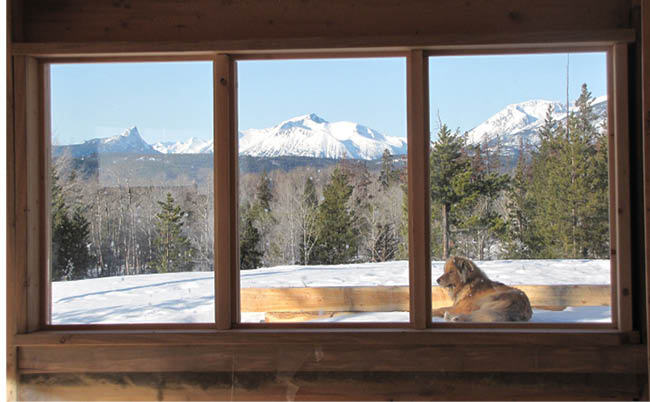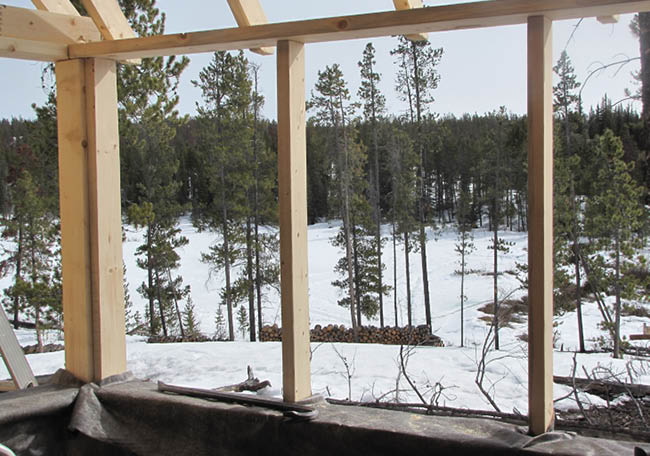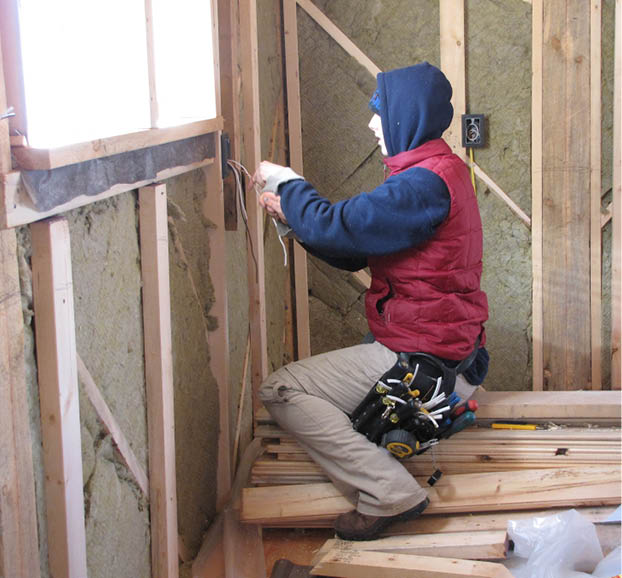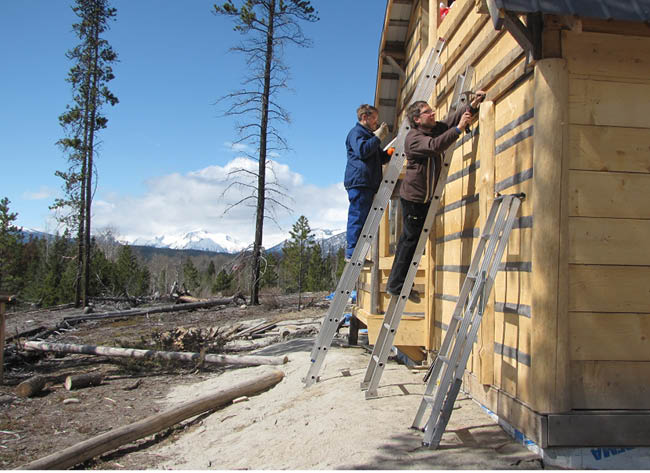chapter 20
[The initials of the locals have been changed. It is unknown who M— and B— were, so their names have not been included either.]
Dear M... and B...
Thank you so much for all the nice things you did for me. I’m so glad you both seem so well and happy . . .
The truck has a few minor rattles—the glove compartment catch fell apart and the hazard light wouldn’t turn off. Luckily, Jim from Towdystan was here working on the Datsun and fixed both temporarily. . . . The glove compartment fell off previously and the book of directions was locked in.
The cat population is getting up there again. Sylvia has three greys and a minute black. Annie had her kittens under the barn then hauled them onto my bed. So far I have homes for three or four older cats and three kittens.
The caretaker did boom all except fiddle about. A real do your own thing hippie turned Jesus freak—along with A... and D... God in his wisdom saw fit to make A... impotent so now he is pious rather than lecherous . . .
F... underbid S... for doing the garbage dumps. I’m sure F... will make it pay. He has no machine in working order to do the job! Now only F... boozes. The rest are all “Born Agains.”
I’ll write anon.
Love, Ginty.
—Extract from a letter to unknown people.
It was found inside a magazine at Ginty’s house, so presumably was never sent
We had a reasonable amount of snow that winter; most of it fell while I was away on my book tour. Sarah emailed me that she was quite happy being snowed in. I arranged to have the road ploughed at the end of November but more snow fell before I arrived home on December 5. It was a little slithery driving on the road and I wasn’t sure how Sarah’s car with no winter tires or all-wheel drive would handle it. It was -27°C and dark when she wanted to leave. I had to jump-start her car and I drove with her to the highway but she made it okay and had no trouble with the rest of her journey.
The book tour was a disaster. When I don’t have a new book I often travel to locations further afield, and I had arranged a trip east to Banff and then south to the Nelson area before going to the Lower Mainland. In the past, libraries would obtain grants from the BC government to pay speakers and often contributed toward travel expenses as well. Premier Gordon Campbell, in his wisdom, had cracked down on all the arts’ support grants. I did not know this until after I had arranged the trip, and when so many people had worked hard on my behalf I didn’t like to cancel. Speakers’ fees and travel grants were therefore virtually non-existent. I had been counting on grossing the usual $3,000 or $4,000 by the end of the tour to pay my regular fall bills, but I made a quarter of that. I was on the road for five exhausting weeks; I would have been better off staying home and doing something constructive. The immediate bills—land office fees for the mountain business mostly—amounted to $3,300. I begged a $1,000 loan off my publisher while down at the coast but that disappeared almost at once because my van wouldn’t start (it never did like wet coastal weather) and had to be towed; the garage replaced all the electronics (without telling me they were going to do it) and charged $800. “Ouch,” said my publisher. “Pity it didn’t happen over here [Sunshine Coast]. We have a great mechanic and all the van probably needed was a $1.50 wire.” But there was nothing I could do about it.
I’d had a few enquiries re the sale of the mountain business but none of these had come to anything. Katie from the Bella Coola Valley lent me a couple of thousand. I had never been in that kind of debt before. The publisher would get his money back when the royalties came out in June but I did not know when I would be able to pay Katie. In the meantime the government was threatening to close the lease on the mountain resort if I didn’t come up with the rent. There was no work locally and for me to try and find something elsewhere was not practical. Firstly, I would need somewhere to live; secondly, I had two large dogs to deal with. They were not apartment material. A low-wage job in town, even if it was available, would not be enough to pay living expenses. So I hunkered down at home and drove for mail, water, occasional groceries and to the library as little as possible. I did not feel I could afford any other social life.
Recreational asthma was now added to my health concerns. This had been plaguing me for years but only in a minor way. Now it had become a major problem. Just walking from the cabin to the upper property was enough to set it off. Sometimes it was so bad that after the shortest spell of activity I would be gasping for hours. Not only was I not getting enough exercise, I was also suffering mentally. Walking and observing nature is my raison d’être. To have to restrict it was driving me crazy. I knew the asthma’s upsurge was most likely a response to my financial woes but no amount of acceptance of this seemed to make any difference. I began to think I was going to be like Ginty—start a big dream and then have to give up long before it was finished due to ill health. Ginty was only a few years ahead of me when she died. On the internet I came across a site that recommended wearing a scarf over one’s mouth to moderate the effects of asthma, and that helped a lot.
I also suffered dreadfully from a lack of fresh vegetables. I grew sprouts: alfalfa, sunflower, lentils, radish, fenugreek, clover, and broccoli if it didn’t rot, but somehow they weren’t enough. I craved bok choy, kale, chard and other leafy greens. The local stores supplied none of these; when I asked about them the storekeeper said I would have to order stuff like that by the case as no one else would buy it. I didn’t have a fridge or a freezer—my small solar power system would not run the electric fridges available at that time, and propane fridges were incredibly expensive. The storage place I had built to stop the produce freezing when I went away was not a lot of use at keeping things cool. I had coolers and blankets but, even using these, the porch was usually too cold and the inside of the cabin too warm so fresh food did not last long. I spent a lot of energy dragging the coolers out for a short time during the day and bringing them back inside at night but buying case lots of vegetables was not going to work. Besides, anything acquired locally was riddled with chemicals. I could not wait for my life to get less complicated so that I could grow a garden and process my own food.
I researched the possibility of having organic produce brought up from the coast but this would involve two freight trucks—one north to Williams Lake and the other west onto the Chilcotin. Both trucks would have to be refrigerated. For a ten-kilogram box, each truck wanted payment; together that totalled $60. A ten-kilogram box of produce would probably cost less than half of that in the first place. So I put up with rubber broccoli, ancient green peppers speckled with soft depressions of rot, and spring onions covered with slime. During the first part of the winter I worked on A Wilderness Dweller’s Cookbook. It was more a dissertation on the difficulty of getting food into the wilderness than a collection of recipes, and I wanted to call it The Hundred Mile Diet, Ha Ha Ha, but although the title was used for a chapter inside, the publisher wouldn’t go for it on the cover.
As the bones of the book took shape I was able to put it aside periodically and start to work on the house. Sarah had not been idle while I had been away. She had finished the wall fillers, framed what I hoped was going to be a bathroom, insulated the whole floor and covered it with plywood, and fitted the first layer of studs for the wall insulation. (I had a chuckle when I found a couple of timbers decorated with splodges of dried blood: Sarah must have given herself a few good whacks with the hammer!)
As I had done with the cabins in the mountains, I wanted to make two layers of insulation in the walls. Part of the reason was to cover the first row of studs, which would reduce leakage of heat, but placing one of the layers on the diagonal would also make the structure much stronger. Sarah had put the diagonals in, nailing them not only to the uprights and the floor but also to the wall boards. It would take a major earthquake to shift the building now. I would fit the insulation between the diagonals and put a second layer of studs vertically on top. They would not only contain the extra insulation but would also provide a structure to support the pine tongue and groove I was going to use for the interior walls.
Before tackling the insulation, however, I fitted the window that faced the mountains. I had already bought the double-glazed units; all I had to do was make a frame for them. Because the window holes were all boarded up it was very dark inside the house. It was also cold; letting sunlight into the room through glass would help make the temperature more comfortable to work in. I picked an afternoon that wasn’t too chilly and wrenched the plywood off the big window hole facing the mountains: light flooded in. The design of the window was a triptych; double-glazed units are heavy and I could not have lifted a picture window unaided. Besides, I thought the smaller panes more practical; if one of them broke, it would be less expensive to replace. The afternoon sun lay in slabs along the floor and cheered the place up considerably.

The first window in the new house.

The beginnings of the bay window in the new house.
The first round of insulation was next, and then I started the other main window. This would look out over the pond. Once more I was going to go through the monstrous frustration of building a bay window. Each one I have built faces the sunrise and I can sit and read or lie in bed and watch the morning come into the world. This bay window, which looked over the pond, took weeks to construct. I would do part of it and then have to be involved with something else for a while. For a time it was open, then I blocked it with tarps, but the rain and snow still blew in at times. The last of the glass wasn’t fitted until the fall.
It was an extremely gloomy winter. It was mostly quite mild, although the temperature did stay below freezing most of the time. But day after day a lid of freezing fog clamped down on our world. This extended over most of central BC. In Williams Lake and 100 Mile House the conditions were similar except the ground temperature was higher and they soon had no snow at all. Such conditions had not been seen in 100 Mile in living memory. The gloom was exacerbated as the shortage of power meant I was condemned to candlelight during the dark hours. I am like the solar panels: I need sun to keep my batteries charged. In a city I would be a SAD sufferer for sure. I am often asked why I don’t use the wind to create electricity. The setup is cheaper to set up than solar but windmills wear out quickly and sometimes break; also, I hate the noise. When they are operating, they whirr or whine. If they are attached to the house the whole building hums. The main reason I don’t have them, however, is the weather. In between storms, winters are usually calm. It is heat that generates air movement in the sky. In summers there are few days without some kind of breeze but then I have all the power I can possibly use. During the six-week spell of ice fog that we had that year, the air was absolutely motionless and a wind-powered turbine would not have been any use at all.
Sometimes the fog layer would allow a blurry gleam or two of sun and I could work a little longer on the computer. The laptop doesn’t take much power so once I had finished my email I would disconnect the satellite internet while I worked on the manuscript. The publisher rejected the first draft of the cookbook; I rewrote a chunk but he liked that even less. We eventually agreed on content that we could both live with. The cookbook would be published in the fall.
I put up the vertical studs but did not finish the second layer of insulation because the house was to be wired. Even if I never used hydro, I wanted the wiring to be done properly. Enter Sarah again, but this time with her parents. It so turned out that her dad was an electrician. When he had brought Sarah up during the summer his eye had fallen on the hideous green Chevy, which, as we had needed no extra help to finish the roof, was still sitting there. A lot of people wanted that truck: I could have traded it for a trailer or for help to construct the roof, and now Bert was salivating over it. I couldn’t imagine a more ugly vehicle; presumably it was a man thing. Bert’s wife, Yvonne, also looked at it askance. “I have another just like it at home,” Bert enthused. The upshot was, he agreed to do the wiring in return for the truck and some time at my mountain resort. This was a huge bonus for me, not only regarding the cost but because it was almost impossible to persuade an electrician to work this far away from Williams Lake.
Bert and Yvonne did the work over Easter weekend, which was at the beginning of April that year. I ordered a bunch of veggies from Williams Lake; the Gregersens would pick them up on their way through. As an afterthought, I asked the store for an Easter lily. Poor Sarah! I had not realized that the Gregersens were going to be travelling in a small car. None of them are small people and the car was already stuffed full of tools and electrical gear. The veggies were packed into two apple boxes and the Easter lily was huge. Sarah had to sit with it on her lap the whole three and a bit hours from Williams Lake.

Sarah helping her dad with the wiring.
It was bitterly cold. The wind whistled through the doorless door holes and the unfinished parts of the windows. Bert and Sarah (who was working toward her electrician’s ticket) wired, I gophered and Yvonne hugged the cookstove, which was going full bore but provided little comfort. At the end of it I had a bunch of sockets that could be powered by the generator—in other words, I could run heavy machinery if I wanted to—and a separate wiring system for the lights that would be attached to the solar power storage batteries once I had moved the system over. I would now be able to complete the insulation and the inner walls. Bert and Yvonne would come back a month later to put in the switch plates, light sockets and smoke alarms.
On their second visit they also brought a 550-metre extension line for the phone. These kinds of cables are apparently used on construction sites: they can be laid on the ground and, although they are not designed to be driven over, they can withstand a lot of abuse. Having a phone up at the new house was a godsend as I could now deal with phone business without having to run back and forth all the time. The original extension running along the top of the fence to the cabin would be moved once I had finished living there, but for the moment I had two phones. I had put my sleeping bag on a foamy in the bay window of the new house and given Bert and Yvonne the cabin to sleep in as the mattress down there was bigger. I was reminded of Sarah during her first visit when she had said she would phone me from the trailer if there were any bears and I had laughed at her. Bert and Yvonne were able to call me when they were ready to come up for breakfast.
Later that month, Chilcotin Freight dropped off two wwoofers at the end of my road. Etienne and Cyrille were twin brothers from Germany. They had a very individual way of looking at the world. They arrived with piles of stuff—a huge backpack and travel bag each plus a couple of smaller items of luggage. They had wintered on a farm in Northern Manitoba so had a lot of heavy clothes. It did not occur to me that they would not have sleeping bags.
I put them in the trailer. I slept down at the cabin; it was not very restful in the new house as the opaque builder’s plastic that covered most of the glass-less bay window flapped and creaked with the slightest of breezes. On their first morning the brothers were late for breakfast. Part of the reason was that they got lost trying to find the trail between the two places but also they were not sure of the time. Etienne arrived clutching his cell phone. Could he please charge it up? He knew he could not use it as a phone but it was the only clock the brothers had. They had managed to light the little tin stove the evening before but of course it could not stay warm for long and in a couple of hours, without sleeping bags, they were freezing. They lit the stove again and the trailer warmed at once; thereafter they vowed to set the alarm to wake them every two hours so they could relight the fire. The battery did not last the night. Even after I had found them all the spare bedding I had, it wasn’t enough and they continued with this routine for the rest of their stay. The day they left they checked into a motel; Cyrille said later that it was the first proper sleep he had experienced in three weeks.

Cyrille and Etienne nailing battens over the gaps between the boards.
They were hopeless at splitting wood (I ended up doing most of that), they were incredibly slow at anything they tackled, and they ate huge amounts. Basically, I was feeding four and getting the kind of work I would expect from one person. Their saving grace, however, was that they had a penchant for carpentry work where, although they worked slowly, they did a really good job. They first nailed bits of strapping over the gaps between the wall boards, then insulated and laid about half of the floor in the attic. After they had gone, a young man called Gabe helped me for a few days. He did most of the rest of the attic floor; we could not complete it as I had to design the steps up there first and I couldn’t do those until the basement steps were made. So far, we had been accessing the attic with a ladder.
I put the inner wall up in the large porch-cum-workshop and built three doors. Most of the two-by-six tongue and groove fir I had bought to make the doors had warped terribly but I could not afford to replace it. Neither did I have the time, and the doors had become a priority. Firstly, it was still miserably cold working on the interior with the wind whistling through all the openings, and secondly, the hummingbirds were constantly getting inside and freezing or starving to death. Both rufous and calliope breed here, and each species is incredibly aggressive. Hummingbirds are programmed to love red. The flowers that they pollinate are usually red for that reason. The feisty bundles of feathers do not distinguish between organic and non-organic substances, however, and they are equally attracted to gas cans, chainsaws and the red heads of woodpeckers. The shade they liked best, unfortunately, was on the plastic covers of the rockwool batts. We now had copious amounts of these lying about the place and the hummingbirds fought fanatically over them. I had the twins bale the plastic up so we could take it to the dump, and I stuffed the bales inside so the wind would not blow them away. This drew even more hummingbirds indoors. If the birds were in overnight and the morning was frosty, they died. I rescued dozens, grabbing them against the windows and encasing them in my large, rough hands before releasing them with a bumblebee zing back out into the sunshine. Three of them succumbed, however, before the doors were all hung.
One thing I was determined to do before I went into the mountains for the summer was install the skylight over the bay window. Most of the vertical sections where the glass would go were still covered with plywood but I would be able to do those alone and they could wait until the fall. I had never added a skylight to the bay windows I had built before but was always frustrated when I could not see the moon or stars while lying in bed. I visualized a much more elaborate design but with my limited carpentry skills it ended up being quite basic. I used a single long piece of double-paned glass supported in several places underneath. I would never have been able to lift it if Gabe had not been there. While we were up on the ladders we could hear cows bawling. The rancher at Kleena Kleene was driving his livestock along the highway to their summer pasture. In days gone by, all the ranchers used to move their cows on foot, many of them taking weeks to get to summer pastures or the stockyards in Williams Lake. This cattle drive is the last one to be conducted on a public highway in the Chilcotin. The sound was yet another reminder of the turning of the seasons; once again it was time for me to leave for the mountains.